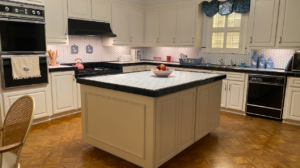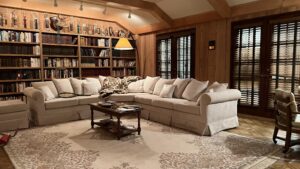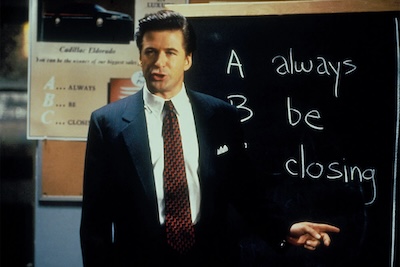Monsters: The Lyle and Erik Menendez Story brought a notorious murder back to our collective cultural consciousness. Audiences may not have been prepared for how this second season in Ryan Murphy’s anthology series would zap us back to the affluent world of California where tennis was king and Batman was the hottest ticket in town. Production designer Matthew Flood Ferguson is no stranger to transporting us back in time, but his work on this new season stunningly depicts and recreates a family’s lifestyle that may seem foreign to so many people.
Ferguson’s face lit up when I first asked him about taking the reins on another period project. One might be surprised to learn that he enjoys the strict guidelines set in place by roadblocks of time which naturally led us to talk about where his process begins. Remember how striking the sets of Netflix’s Ratched were? Those greens are still etched in my brain. Of Jeffrey Dahmer’s dingy apartment and how the shadows made you feel uneasy? What color comes to mind when you think of this second season?
“I love doing period shows,” Ferguson admits. “Once I started doing it in my career, I found it very rewarding. I enjoy creating a place and making it as authentic as possible. Once you know your parameters, it almost makes it easier, in a way. It gives you a framework to work in. I’ve done the ’40s, ’50s, ’60s and now the ’80s and ’90s. I love the furnishings and the cars and everything about it. When I do shows with Ryan [Murphy], one of the first things we talk about is color. For instance, with Ratched, it was all green with some blues. Hollywood went to mustard and golden tones, and I turned the studio with browns and earth tones. Dahmer was a dingy yellow, but Menendez was primarily blue. I find it a great beginning track, and everything builds off of it. You have to find places to access it into the story and then bring other colors into the design.”
I admitted that the Menendez Beverly Hills kitchen is specific down to the cabinets and the drawer pulls. There is something very ’90s about the stark white countertops and the black appliances that really takes us to a time and place.
 “We had a black hood above the range, so it was white and very graphic with black accents with blue in the curtains,” he says. “The wallpaper was white with some blue detail. There you have white, black, and blue. The floor is a wood checkerboard even though you only see the floor once, but things begin to unfold fairly quickly when you can establish the palette like that.”
“We had a black hood above the range, so it was white and very graphic with black accents with blue in the curtains,” he says. “The wallpaper was white with some blue detail. There you have white, black, and blue. The floor is a wood checkerboard even though you only see the floor once, but things begin to unfold fairly quickly when you can establish the palette like that.”
Leslie Abramson’s kitchen, by contrast, may surprise audiences after they see her confidence and toughness in the courtroom. The wood is warmer and lighter, and when she is at home, we get an idea of how she wants to revisit the idea of being a mother. It’s a very inviting space.
“I love that kichen,” he says. “Obviously, not every set is built on a stage, and I went out with the location manager so we can dress and augement for what we need. It was a cold scout, so we were literally knocking on doors and asking people if they would be interested in letting us film there. The kitchen, to me, felt like her, and the rest of the house worked really well for her. I fought for that, because it felt like 1988. It’s a bit softer.”
Even though we only see it briefly, Erik Menendez’s bedroom informs us about a young man on the cusp of adulthood. After selecting a color, Ferguson and his set designers could fill the space of a young man who may have felt adrift in his own home. How much does Erik have to show off about himself as he discovers who he is?
“With every set I do, you never know how much you are going to see,” Ferguson says. “I wanted his room to have cool greys with a little bit of red–darker tones. I felt it was an isolated space. My mother-in-law had passed away in Louisiana, and she had curtains in a guest bedroom that were grey with a little red accent. I contacted the owner and she knew who I was since she knew my partner, and I offered to pay for them to include them in Erik’s room. My set decorator, Melissa Licht, loved them, and those curtains helped design the entire room in terms of tone. It kind of looked like a 1980’s album cover or a [Patrick] Nagle print. You don’t really see them, but we did the metal mini-blinds, and our team decided to have a black section in the middle.
Erik’s room was sort of messy and he had his work out weights. A lot of books and tennis clothes and racquets strewn about. There was a famous illustrator that we commissioned to have a print to hang over his chest of drawers. We used the red trash as a little bit of foreshadowing. In the parents’ bedroom, there is red as well. I felt compelled to use this bold red for the carpet, and it was a little unsettling. It was an uneasy feeling. Ironically enough, I didn’t have any pictures of that room, and after we started shooting, someone showed me a video on TikTok from their home. One of the pictures showed Jose Menendez lying on the floor, and the carpet was red.”
 When it comes to a very photographed space like the crime scene, how much freedom do you have? Do you make subtle changes to aid in the production or do you aim for absolute precision in recreation? Ferguson built out the infamous crime scene from photographs, and the attention to detail is nothing short of astounding. The minute a piece of furniture doesn’t match what we remember or if the room felt too spacious, it would take us out of the moment entirely. Luckily for us, Ferguson’s love of period and accuracy came in handy.
When it comes to a very photographed space like the crime scene, how much freedom do you have? Do you make subtle changes to aid in the production or do you aim for absolute precision in recreation? Ferguson built out the infamous crime scene from photographs, and the attention to detail is nothing short of astounding. The minute a piece of furniture doesn’t match what we remember or if the room felt too spacious, it would take us out of the moment entirely. Luckily for us, Ferguson’s love of period and accuracy came in handy.
“The images of the Menendez home mainly came from the crime scene,” he says. “We had a lot of material of shooting from one direction towards the bookcase.. We see that room a lot from one way as we see the crime happen again throughout the season. I wanted to match that identically as possible. I spent a lot of time with our set designer, Kristen Davis, and supervising art director, Helen Harwell, on calculating the spacial relationship to convert it to architectural plans to make sure it was historically accurate. And to make sure that we can film in there. You want the size of the room to feel correct while remembering that you need to get a camera in there.
We custum built three sofas so we had the ability to do retakes, and we found the exact same television and built that in. The one thing that I couldn’t do was the pitch of the ceiling. It was much steeper in the house, and I went up as far as I could. We had a two-story set. I spent a lot of time measuring from the French door to the back of the sofa, because I knew in a future episode, when Dominick Dunne is there, that we needed to see the guys bursting through to commit the crime even though that’s not what they did. That’s how he saw it. Because the crime scene was so well-known and so seen, I had to really look at the finest of details.”
Have you ever thought about how production design extends to cars that we see in pivotal scenes? Lyle and Erik find privacy when they are driving around talking about their plans or when they are trying to make up their alibi. Towards the end of the season, Lyle yells at Jose because his father isn’t buying a car up to Lyle’s standards, and vehicles are important in maintaining this idea of the family’s wealth.
“Jose had a 4-door Mercedes 300 SEL that we found from a collection that was in perfect condition,” Ferguson says. “Kitty had a 2-door black convertible that we bought from San Francisco, but we had to also find the Alfa Romeo and Erik’s Ford Escort. There is a coordinator that I work with, Randy Wolf, to source the cars. He will go to his resources, and if they aren’t the right color, we paint them. We needed two Alfa Romeos for shooting, but it’s also all the background cars and squad cars. We see Jose’s car quite a bit like when he takes them around to apologize for breaking into people’s homes. When we are in the car, you can see the quilted door and that’s such a seemingly small detail, but it speaks so much to the period. They also set the feeling of the family and shows how they had money. It helps show off their extravagent lifestyle.”
The third season of Murphy’s anthology that centers on Ed Gein–played by Charlie Hunnam–begins filming this month. While I knew that Ferguson couldn’t really give anything away, I had to ask if he could give us a hint on the color scheme.
“You know I can’t tell you that,” he says, with a sly grin.
Monsters: The Lyle and Erik Menendez Story is streaming now on Netflix.








![We Could Go See BOOP! And Predict the Tony Awards! [PODCAST]](https://thecontending.com/wp-content/uploads/2025/06/tonys-120x86.png)
